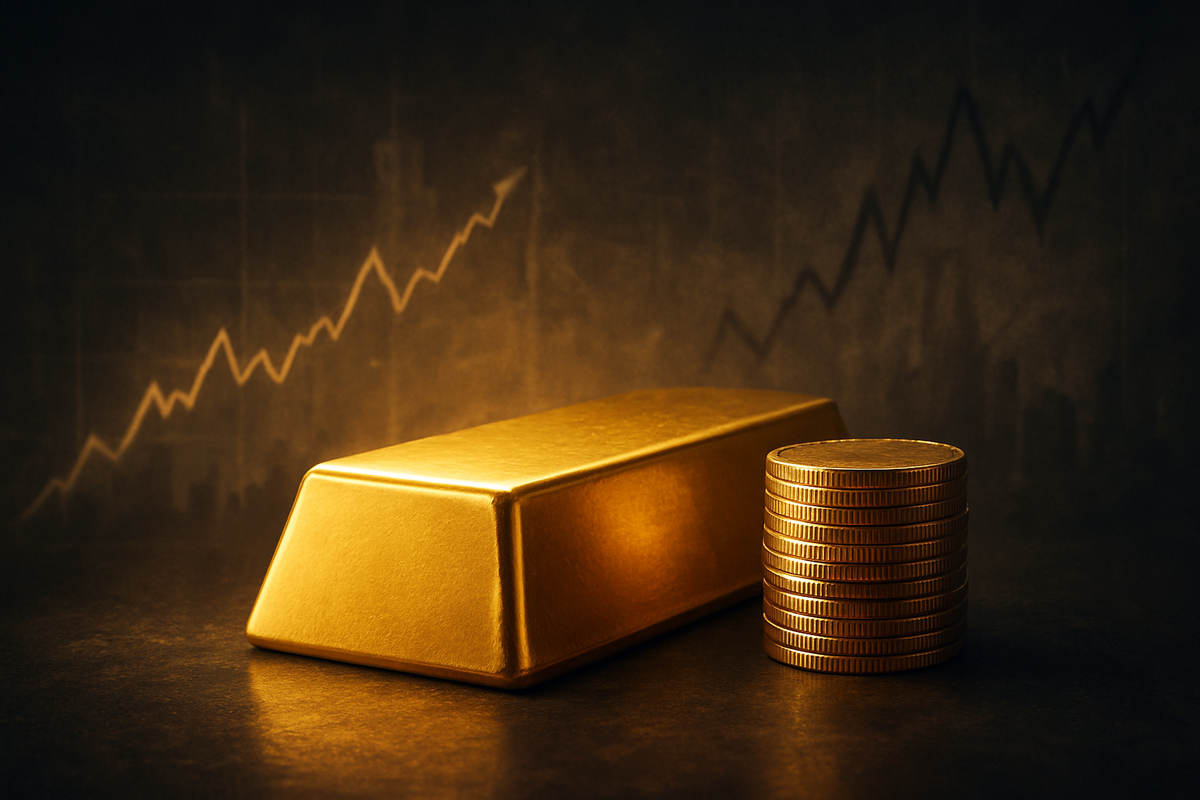
November 5, 2025 – In a move that underscores a deep-seated risk aversion pervading global financial markets, gold has continued its impressive rally, gaining significant ground despite the release of robust US payrolls data. This seemingly contradictory market behavior signals that investors are prioritizing capital preservation and hedging against broader systemic risks over positive domestic economic news. The resilience of the yellow metal, even as the US labor market shows strength, highlights a profound global unease that is driving a flight to safety.
Normally, strong US employment figures would bolster the US dollar and temper expectations for Federal Reserve interest rate cuts, typically exerting downward pressure on non-yielding assets like gold. However, gold's current appreciation suggests that other, more pressing fears—ranging from geopolitical tensions and persistent inflation to concerns over equity valuations—are dictating investment decisions, signaling a market sentiment characterized by a preference for safety over growth.
Unpacking the Paradox: Payrolls, Prices, and Precious Metals
The recent market dynamics, particularly in late October and early November 2025, have been shaped by a complex interplay of economic data, central bank sentiment, and overarching investor anxieties. The latest US payrolls data, while indicating a mixed but generally improving labor market, failed to deter gold's upward trajectory.
On November 5, 2025, the ADP National Employment Report for October revealed that private sector employment increased by a stronger-than-forecast 42,000 jobs, a notable rebound from a revised 29,000 job loss in September. Simultaneously, the Institute for Supply Management (ISM) Services PMI for October registered a robust 52.4%, indicating renewed expansion in the services sector and exceeding forecasts. However, the Employment Index within the ISM report contracted for the fifth consecutive month, albeit at a slower pace, offering a nuanced view of the labor market's health. These reports, given a delay in official government jobs data due to an ongoing US government shutdown, carried significant weight.
Leading up to these releases, gold prices experienced volatility. On November 4, spot gold had slipped by over 1% as the US dollar strengthened, reaching a three-month high. However, upon the release of the stronger-than-expected ADP report, gold, which had seen earlier gains, trimmed some of them but largely held its ground, trading around $3,975 per ounce. This resilience was largely attributed to a broad risk-off sentiment across global equities and renewed buying interest after a recent dip. Key players in these dynamics include the Federal Reserve, whose monetary policy decisions (like Fed Chair Jerome Powell's cautious remarks on rate cuts) heavily influence market expectations; global investors and traders; and central banks worldwide, which have been consistent buyers of gold as a strategic reserve asset.
The initial market reaction underscored the prevailing sentiment: while strong payrolls data might temper immediate rate cut expectations, the overarching flight to safety, driven by concerns over equity valuations (especially in tech) and geopolitical risks, provided a powerful counter-narrative, preventing a sharper decline in gold prices. The interplay between a strengthening dollar, reduced rate cut expectations from strong data, and pervasive risk aversion created a delicate balance, ultimately favoring gold's safe-haven appeal.
Corporate Fortunes: Winners and Losers in a Risk-Off Environment
The current market environment, characterized by gold's safe-haven rally despite strong US payrolls, creates a bifurcated landscape where certain public companies are poised to thrive, while others face significant headwinds. This scenario highlights a market prioritizing stability over aggressive growth.
Unsurprisingly, gold mining companies are the most direct beneficiaries. Higher gold prices directly translate to increased revenue and expanded profit margins. Major producers like Newmont Corporation (NYSE: NEM) and Barrick Gold Corp. (NYSE: GOLD) have seen their stock performance surge, with many smaller and mid-tier miners, often tracked by ETFs like the VanEck Junior Gold Miners ETF (NYSEARCA: GDXJ), amplifying gold's gains. With elevated prices, these companies are likely to boost exploration budgets, advance new projects, and invest in operational efficiencies to maximize profitability. Similarly, gold royalty and streaming companies, such as Franco-Nevada Corporation (TSX: FNV) and Royal Gold Inc. (NASDAQ: RGLD), also benefit significantly. Their business model—providing upfront capital to miners in exchange for a percentage of future production—offers leveraged exposure to rising gold prices with less operational risk, making them attractive defensive investments.
Conversely, sectors sensitive to consumer confidence and global economic stability are likely to struggle. Consumer Discretionary companies, including those in hospitality, luxury goods, and non-essential retail, face pressure. Even with strong US payrolls, if global risk aversion translates into cautious consumer spending or if inflation erodes purchasing power, demand for discretionary items can fall. Companies like Amazon (NASDAQ: AMZN), Tesla (NASDAQ: TSLA), and Nike (NYSE: NKE) could see their performance dampened if broader economic anxieties outweigh domestic employment strength.
Furthermore, growth stocks, particularly those in the highly valued technology and artificial intelligence (AI) sectors, are vulnerable. The gold rally itself has been fueled by concerns over overstretched equity valuations and warnings of an impending market correction in AI-driven equities. If strong payrolls lead to expectations of sustained higher interest rates, the future earnings of these growth companies become less valuable, and borrowing costs increase. This environment could prompt investors to rotate out of speculative, high-beta tech stocks towards more stable assets. Companies with high debt loads are also at risk. If the safe-haven demand for gold is partially driven by inflation concerns or expectations of sustained higher interest rates, highly leveraged companies will face increased financing costs, eroding profit margins. This scenario favors companies with robust balance sheets and less reliance on cheap credit.
Wider Significance: A Shift in Global Financial Tides
Gold's unprecedented rally, even amidst strong US employment data, signals a profound shift in global financial tides, transcending immediate economic headlines. This counter-intuitive movement is deeply embedded within broader industry trends, carrying significant ripple effects, policy implications, and echoes of historical precedents.
The most significant trend is the persistent global uncertainty that outweighs localized economic strength. Despite positive US jobs figures, a "risk-off" sentiment dominates, fueled by overstretched equity valuations (especially in tech and AI), escalating geopolitical tensions (e.g., ongoing conflicts, US-China friction), and the lingering specter of inflation above target. This environment reinforces gold's traditional role as an inflation hedge and a store of value. A critical driver is the aggressive accumulation of gold by central banks globally. Countries like China, India, and Turkey are diversifying their reserves away from the US dollar, driven by concerns over currency weaponization and de-dollarization. This strategic shift is further supported by Basel III capital standards, which classify gold as a Tier 1 asset, enhancing its appeal for institutional holders.
The ripple effects are far-reaching. While gold rallies, the US dollar has also shown strength, creating a complex dynamic. Typically inversely correlated, their simultaneous rise suggests that the underlying risk aversion is potent enough to override traditional relationships. This also impacts other safe-haven assets; while Bitcoin initially saw drawdowns, its subsequent resilience suggests its maturing role as a secondary hedge. For gold mining companies, this environment is a boon, leading to exceptional stock performance and increased investment in exploration and production. Conversely, sectors like jewelry and technology, while contributing to gold demand, are less influential on price than investor and central bank activity.
From a regulatory and policy standpoint, the persistent risk aversion complicates central bank monetary policy. While strong employment might suggest less need for rate cuts, underlying economic vulnerabilities or a sustained manufacturing contraction could force the Federal Reserve into a more dovish stance, further bolstering gold. The de-dollarization trend driven by central bank gold accumulation has long-term implications for the US dollar's global reserve status. Moreover, changes in taxation policies, such as China's reduction of VAT exemption on gold, can subtly influence demand in major consumer markets.
Historically, gold has surged during periods of profound uncertainty, even when some economic indicators were positive. The early 2000s (post-9/11 and dot-com bust), the 1969-1980 era (double-digit inflation and oil shocks), and the 2008 Global Financial Crisis all saw gold rally as investors sought safety. More recently, gold hit record highs in late 2023 amidst positive US economic news but heightened war fears. The current rally in late 2025, reaching an all-time high of $4,381.58 in October, reflects this confluence of geopolitical instability, inflation concerns, and a fundamental shift in central bank strategies, positioning gold for a sustained "golden bull run" if global uncertainties persist.
The Road Ahead: Navigating the Golden Era
The current market landscape, where gold's safe-haven appeal trumps strong US payrolls, sets the stage for a compelling period ahead for investors and corporations. Both short-term volatility and long-term structural shifts will define the trajectory of gold and broader financial markets.
In the short-term (late 2025 - early 2026), gold is expected to remain sensitive to macroeconomic data, particularly inflation readings, employment figures, and Federal Reserve policy pronouncements. However, a persistent "risk-off" sentiment, driven by ongoing geopolitical tensions (e.g., US-China trade policies, regional conflicts), concerns over elevated equity valuations, and a potentially weakening US dollar, will likely provide a robust floor for gold prices. Analysts from J.P. Morgan, Goldman Sachs, and UBS generally maintain a bullish outlook, forecasting average prices ranging from $3,675/oz to $4,000/oz within this timeframe. Gold may experience periods of consolidation after its significant rally, but underlying demand is expected to sustain its strength.
Looking at the long-term (2026 - 2030), the outlook for gold remains strongly bullish, signaling a potential structural bull market. Projections from major institutions like HSBC and Bank of America suggest gold could surge to $5,000/oz by early 2026 or later in 2026. InvestingHaven forecasts a peak of $5,155 by 2030. These long-term drivers include sustained central bank purchases for diversification, continued investor demand for hedging against economic uncertainties, persistent global fiscal debt, and potential for a weakening US dollar.
For the broader market, particularly equities, the "overheated" perception in sectors like AI and technology suggests caution. A significant economic downturn or a market correction, as warned by some banking chiefs, could lead to substantial equity sell-offs, prompting a further rotation into defensive assets like gold. The ongoing de-dollarization trend, evidenced by central bank gold accumulation, could also have long-term implications for the US dollar's global standing.
Strategic pivots will be crucial for investors. Increased tactical allocation to gold—whether through physical gold, ETFs, or gold mining stocks—is recommended, with some advocating for portfolio allocations up to 25%. Reallocating from potentially overvalued S&P 500 and mega-cap tech stocks towards gold, gold miners, and international equities could enhance returns and lower portfolio risk. For gold mining companies, the focus will remain on production efficiency, operational scale, diversification across stable regions, and strong ESG credentials to attract premium valuations. Other sectors must prepare for potential market volatility by strengthening balance sheets and optimizing operations.
Potential scenarios include a "soft landing" for the US economy with persistent gold demand, a "hard landing" leading to a significant market correction and a gold surge, or a "stagflationary environment" where gold thrives as an inflation hedge. Any hawkish stance from the Federal Reserve due to persistent inflation could temporarily pressure gold, while a dovish pivot would likely boost prices significantly.
Wrapping Up: Gold's Enduring Luster in a Volatile World
Gold's remarkable rally throughout 2025, defying the conventional wisdom that strong US payrolls data would dampen its appeal, serves as a powerful testament to its enduring role as a safe-haven asset in a world grappling with profound uncertainties. This market behavior signals a deep-seated risk aversion, where investors prioritize capital preservation and hedging against systemic risks over immediate economic growth indicators.
The key takeaway is that the market is looking beyond the immediate positive headlines, responding instead to a complex tapestry of geopolitical tensions, persistent inflation, overstretched equity valuations, and a structural shift in global reserve management driven by aggressive central bank gold accumulation. This decoupling from traditional drivers underscores a fundamental re-evaluation of risk and value in financial markets.
Moving forward, the market is poised for continued volatility, but with a strong underlying bullish sentiment for gold. While some analysts anticipate a more moderate increase in 2026 after an extraordinary 2025, the long-term drivers—including ongoing central bank demand, investor hedging against economic and geopolitical risks, and concerns over currency debasement—are expected to sustain gold's upward trajectory for years to come. The "golden bull run" appears far from over.
For investors, gold has solidified its position as an indispensable component of a resilient portfolio. Its ability to act as a hedge against inflation, currency depreciation, and market turmoil makes it particularly attractive in the current environment. Investors should closely watch for any escalation or de-escalation of geopolitical conflicts, the Federal Reserve's evolving monetary policy stance, future inflation and jobs data, the strength of the US dollar, and the overall volatility in global equity markets, especially in the tech sector. Furthermore, monitoring central bank gold purchasing trends will provide crucial insights into the metal's fundamental demand. Gold's luster is not merely a reflection of current fears but a beacon guiding investors through the turbulent waters of global finance.
This content is intended for informational purposes only and is not financial advice




